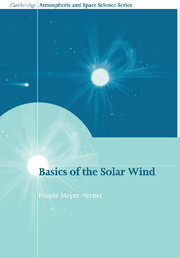Book contents
- Frontmatter
- Contents
- Preface
- 1 The wind from the Sun: an introduction
- 2 Tool kit for space plasma physics
- 3 Anatomy of the Sun
- 4 The outer solar atmosphere
- 5 How does the solar wind blow?
- 6 Structure and perturbations
- 7 Bodies in the wind: dust, asteroids, planets and comets
- 8 The solar wind in the Universe
- Appendix
- Index
8 - The solar wind in the Universe
Published online by Cambridge University Press: 22 October 2009
- Frontmatter
- Contents
- Preface
- 1 The wind from the Sun: an introduction
- 2 Tool kit for space plasma physics
- 3 Anatomy of the Sun
- 4 The outer solar atmosphere
- 5 How does the solar wind blow?
- 6 Structure and perturbations
- 7 Bodies in the wind: dust, asteroids, planets and comets
- 8 The solar wind in the Universe
- Appendix
- Index
Summary
‘To an astronomer, man is nothing more than an insignificant dot in an infinite universe,’ someone once said to Einstein. To which Einstein replied: ‘But I realise that the insignificant dot who is man is also the astronomer.’
What is the solar wind to an astronomer? I shall not address this question in detail, but only briefly examine how the solar wind interacts with its cosmic environment, and how it compares with some other cosmic winds. I also address briefly the physics of cosmic rays, their acceleration and their interaction with the solar wind.
The frontier of the heliosphere
In studying the interaction of the solar wind with objects in Chapter 7, we omitted one major obstacle: the interstellar medium.
In the long term, the interstellar medium is the direct partner of the Sun in the galactic system; it served as a source of matter for the formation of the Sun and the Solar System; in turn the Sun returns matter to the interstellar medium via the solar wind at a rate of about 106 tonnes per second, a figure that will change dramatically in the final phase of its life.
In the short term, we saw in Section 5.2 that the interstellar medium plays a major role in the solar mass ejection, by providing the low-pressure exit of the solar wind nozzle. We address in this section this aspect of the interaction, studying the large-scale structure of the cavity – the heliosphere – that the solar wind carves in the interstellar medium.
- Type
- Chapter
- Information
- Basics of the Solar Wind , pp. 419 - 450Publisher: Cambridge University PressPrint publication year: 2007



